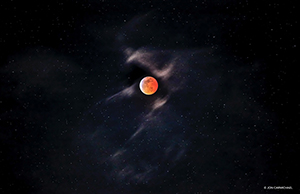| |
Capturing the Beauty of a Solar Eclipse on Film
| |  | | | Jon Carmichael.
|
Jon Carmichael has been photographing solar and lunar eclipses for more than a decade. Carmichael shot to fame in 2017, when he captured an astounding photo of a total solar eclipse from an airplane at 39,000 feet flying above the Snake River in America.
He has been invited to speak about his work, known as astrophotography, at NASA, TEDx and Twitter, and has gained international acclaim for his photos, counting Elton John as one of his biggest collectors.
“Since childhood, I’ve always been amazed by the natural beauty of the earth and the night sky. It creates so much curiosity and wonder. When I became a photographer, I naturally gravitated toward that genre of photography,” Carmichael told VM. “The camera became more of a tool to be able to explore the universe and see things that we aren’t able to see with the naked eye.”
He said one of the greatest things that draws him to photography is the ability to capture a moment in time that may never happen again and share that beautiful moment with others.
 |
| | This photo was shot from Chile at the Cerro Tololo Observatory in July 2019. © Jon Carmichael |
| | | |
Despite years of photographic solar eclipses, he said there is still great risk associated with this line of work.
“The riskiest moments are the partial phases before and after totality, when the moon hasn’t quite fully covered the sun. During totality, when it gets completely dark, you are able to look at the sun with your naked eye,” he said. Carmichael encourages people to travel to a place where they will be able to experience the eclipse, but warns them to take the right precautions.
“You have to protect your equipment— even if it’s just a phone camera— and of course, your eyes. Camera lenses are powerful and can magnify the intensity of the sun, and the sensors that record the image in the camera are extremely sensitive. If you don’t use proper filters, you can damage the sensor very quickly.”
Carmichael recommends amateur photographers, or those who only have a phone available, should consider getting a tripod to ensure a steady and clear image. He said once in totality, the sky will be very dark, so the camera needs to keep still to take a longer exposure.
Recently, Carmichael partnered with Prevent Blindness to create a video that helps explain safety tips and tricks for taking photographs of a solar eclipse.
| 
|
| A lunar eclipse, photographed from Saharita, Ariz. in 2022. © Jon Carmichael
|
Unlike lunar eclipses, which only happen at night, a solar eclipse always happens during the day, because the earth is passing through the moon’s shadow. When this happens, if you’re inside the small 100-mile-wide moon’s shadow, the bright day sky suddenly turns pitch-dark, as if it’s midnight, Carmichael said.
“There is a beautiful 360-degree sunset around you, the temperature can drop 20 degrees, and it’s the only time you can actually look at the sun’s atmosphere with your naked eye. You can see prominence and solar flares shooting off the sun’s surface. It’s absolutely remarkable,” he said.
Due to the rarity of solar eclipses, Carmichael suggests taking the time to experience and capture the moment.
“The eclipse in 2017 was the first total solar eclipse to sweep across the U.S. in 99 years. The next eclipse after April 8 will be Aug. 23, 2044. It’s an unbelievably beautiful phenomena that only lasts a few minutes if you’re lucky. So, to capture such a fleeting and beautiful moment is incredibly unique,” he said.
| |